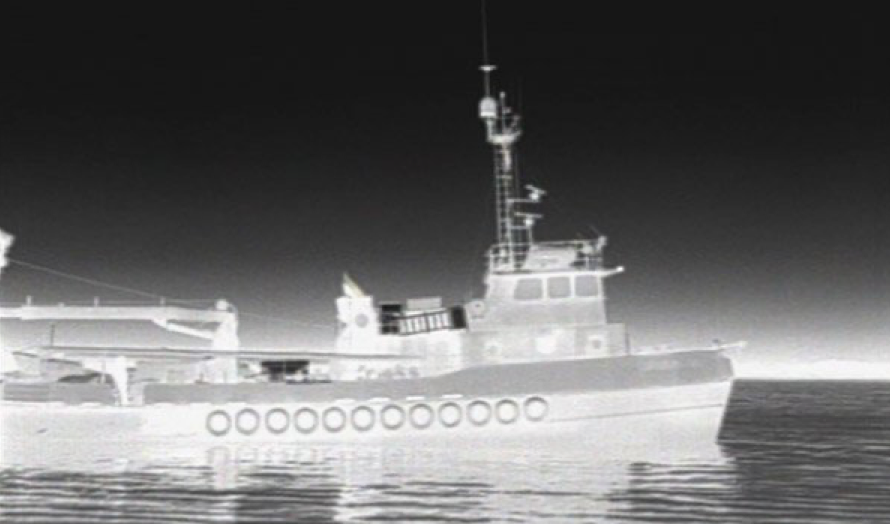Night Vision for Your Boat, Part 2: Themal Imaging

Thermal Imaging is an alternative night-vision system to those that depend on infrared light. Instead of searching for light to magnify, a thermal imager detects radiation based on temperature. All objects emit some level of thermal infrared light; the hotter an object is, the more radiation it emits and the more that will register in the thermal imaging viewer. In part two of our look at night-vision systems, we look at equipment with thermal imaging.
See Anytime
Thermal-imaging cameras can see in total darkness, and through light fog, light rain, and snow. However, the distance they can see is affected by atmospheric conditions. Traditional night-vision devices use optoelectronic image enhancement, which works by sensing small amounts of infrared light that are reflected off objects and then electrically amplifying that light into a characteristic glowing green image. A newer technology, digital image enhancement, captures available light on a digital-image sensor and then digitally enhances the images in a full-color display.
Handheld thermal cameras are useful for small boaters to keep at hand on the console, ready for a quick look anytime the course ahead looks uncertain, and some are so small they readily fit into a jacket pocket.

The maritime environment presents some of the most difficult imaging conditions possible. Conventional low-light or image intensified cameras (green night vision scopes) rely on small amounts of light to produce an image. In many cases, the maritime environment is cluttered with bright lights on the shoreline, which presents a challenging scene for image intensifiers.
Bright lights in the distance can cause a conventional night-vision scope to bloom, making it hard to see targets of interest. And without any light, they don’t perform at all. Conversely, the maritime environment is complimentary to thermal camera technology because you are looking for a warm target against a cool uniform scene.
Distance Matters
FLIR thermal cameras outperform low-cost night vision systems for long range detection and search and rescue, because people and machines show up much better.

Lower cost FLIR cameras are fixed field of view systems optimized for navigation and close range operations. Higher performance systems offer optical zoom lenses that can detect even a small 30’ (9.14 m) outboard vessel beyond 5 nautical miles.
Most thermal cameras can see the moon, but they are low resolution compared to the megapixel visible cameras we have in our smart phones. Available systems commonly have between 320 x 240 or 640 x 480 thermal resolution. And while this seems low, these units with a powerful optical zoom lens can do the job for most boaters.
Particularly when you must leave or return to a crowded harbor in a surrounding city after dark, a high-end thermal camera like the Teledyne FLIR has the advantage of showing the boats themselves. There’s no need to try to make out the running lights of other boats against all the other lighted background.
As long as there is the tiniest bit of temperature contrast between an object and its background, you can see it with thermal imaging.

Easily Implemented
Teledyne says its FLIR thermal cameras are compatible with Raymarine’s Axiom family of multifunction displays and are now compatible with Raymarine’s ClearCruise AR (Augmented Reality) navigation technology. ClearCruise AR accurately displays nearby navigation markers, automatic identification system (AIS) traffic, objects and waypoints in sync with real-world imagery for instant recognition and making complex navigation and high-traffic situations simpler to understand.
The FLIR M300 Series offers single-sensor visible and thermal models, as well as dual-sensor multispectral systems. Active gyro-stabilization and continuous 360° panning offer complete awareness in any direction.
Most thermal imagers are easy to integrate with touch-screen multifunction displays. Using these displays to control where the camera is pointing, displaying its output imagery against maritime charts or radar displays is a tremendous labor-saving device. The systems also make it much easier to avoid floating debris, outcroppings of land, docks, pilings, and small vessels or unlighted boats.
In a man-overboard scenario, the head of a person floating in the water is often the only part that is visible; in thermal imagery, this shows up on the video display as a white ball against a black or dark gray background because the person’s body heat is warmer than the water.

FLIR’s Color Thermal Imaging makes it easy to distinguish the red lights from the green, a major plus when navigating a narrow channel after sundown. Some models also have two-axis stabilization for a clear view in heaving seas.
Top-end boat-mounted thermal systems represent a major investment, but for the fully equipped yacht or sport fisher, the price tag won’t be a sticking point. The FLIR M300 currently lists for about $22,500.
Whether you choose an analog, digital or thermal night vision system, adding one of these very useful devices to your marine electronics will make you a more confident and safer captain, as well as opening up lots more hours in your boating day.